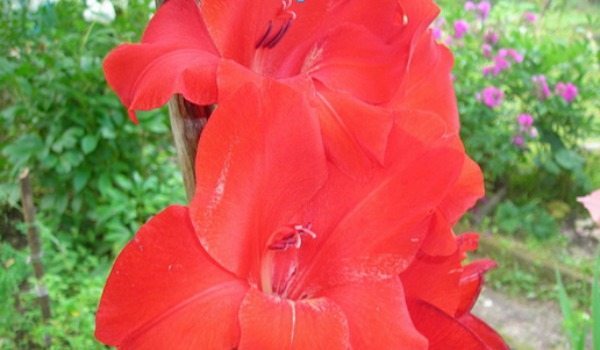
How to Plant Gladiolus Bulbs for Continuous Blooms
Gladiolus is a beautiful half-hardy flower that grows well in warm weather–in fact, just about the kind we’re having now. The name derives from the Latin word gladius, meaning “sword”. The spiked petals give it a distinct shape and the flowers come in a wide variety of vibrant colors, making for a spectacular view in any garden or yard. While they don’t bloom continuously throughout the season, gardeners can plant them on a staggered schedule to ensure that their garden is always bursting with the great colors of this low-maintenance flower.
Gladioli grow from rounded corms that are enveloped in layers of fibrous, brown tunics. They will bloom from July until frost sets in, but the key to getting continuous blooms is to plant new corms every two weeks. Plant them in the beginning of spring; once temperatures reach the 60s and there is no chance of frost, place them around 6 inches deep in well-draining soil with the pointed end facing upwards. Space corms 6 inches apart and water them thoroughly, apply a layer of mulch, and be sure to stake each plant. It takes roughly 90 days from the time of planting before glads bloom and are able to store enough energy to make it through to the next season. Remember that staggering the plantings two weeks apart is what will ensure that you continuously have blooms during the summer season.
Gladioli require little maintenance once they are planted. They generally do not require fertilizer or much watering, but if you get less than 1 inch of rain per week it is a good idea to water them regularly. Be careful not to overwater as this can encourage rot. Once they have flowered, keep an eye out and remove faded or dying flowers to encourage continuous growth. Cut off the stalk once its flowers are gone. Gladioli can look unattractive when they haven’t bloomed, but this can be disguised by growing them in pots and transplanting them once they are ready to bloom or planting them behind other medium-tall plants that bloom when the glads are done, such as zinnias.
Watch for flowers that have been affected by any pests or browning and remove any diseased plants to keep the disease from spreading. At the first frost, dig up the bulbs and allow them to dry for a few weeks before putting them in a cool, dry place for storage. Keep them in plastic mesh bags in a well-ventilated area that stays around 35-40 degrees Fahrenheit and then replant them in the spring. Gardeners who plant this rewarding flower will reap the benefits of the Gladiolus’ lovely shapes and colors.